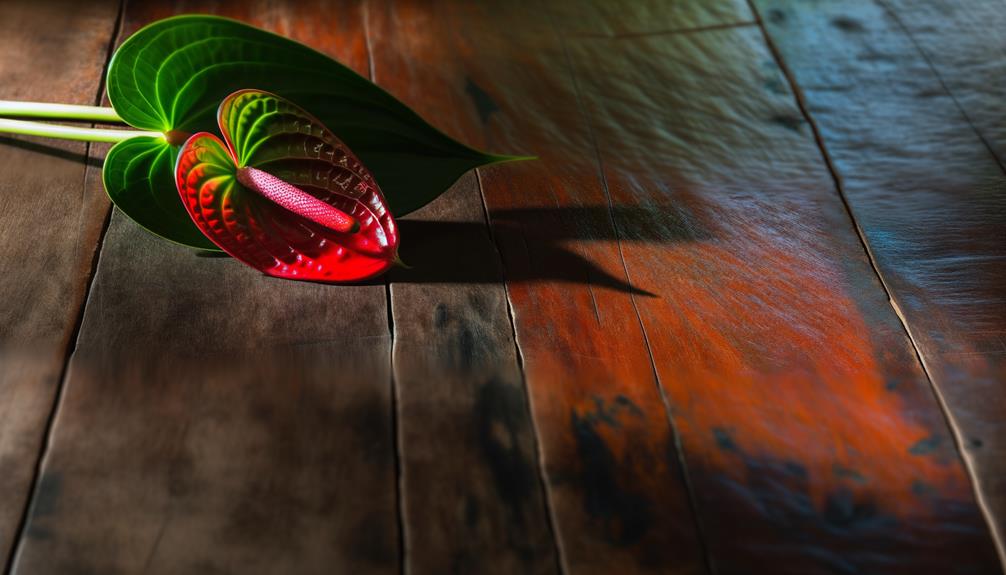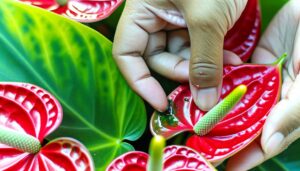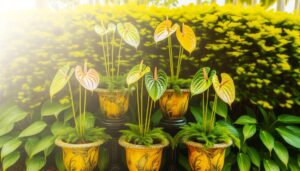Symbolism of a Single Anthurium Flower Laying Down
A single anthurium flower laying down symbolizes emotional vulnerability and introspection. Its open, heart-shaped spathes represent a willingness to expose inner feelings.
This positioning suggests a departure from norms, encouraging exploration and resilience. The chlorophyll concentration changes during this state indicate physiological adaptation, while the spadix and spathe reflect transformation and growth.
In cultural contexts, the anthurium is associated with prosperity, deep emotions, and hospitality. Its horizontal laid position embodies a journey of self-reflection and the harmonious balance between physical and spiritual domains.
For a deeper understanding, look into literary references and spiritual connotations.

Key Takeaways
- Symbolizes emotional vulnerability and introspection, encouraging meditation and self-reflection.
- Represents transition and growth, indicating a temporary state of change and adaptation.
- Reflects resilience and enduring thought, suggesting a departure from norms.
- Holds cultural significance, symbolizing hospitality, deep emotions, and prosperity in different traditions.
- Evokes themes of forbidden love, mystery, and personal growth in literary contexts.
Historical Significance
Throughout history, the anthurium flower has been revered for its unique morphology and vibrant coloration, often symbolizing hospitality and exotic beauty in various cultures. You'll find its significance particularly notable in tropical regions where it thrives.
The genus Anthurium, part of the Araceae family, displays a spadix—a spike inflorescence—and a brightly colored spathe, often red or pink. This intriguing combination has made the anthurium a symbol of welcome and abundance.
In Hawaiian tradition, it's known as the “flamingo flower” or “laceleaf,” embodying warmth and grace. Meanwhile, in Victorian England, its exotic appearance made it a coveted addition to botanical collections, representing a fascination with the unknown. Understanding these historical contexts enriches your appreciation of its symbolism.
Emotional Vulnerability
When you observe a single Anthurium flower, you can appreciate its symbolic representation of emotional vulnerability. This flower's structure illustrates the exposure of one's inner self, highlighting fragility in its display and openness to external influences.
The Anthurium's delicate spathe and spadix serve as metaphors for the human condition of being susceptible to emotional stimuli and external forces.
Exposure of Inner Self
Anthurium flowers, with their open, heart-shaped spathes, serve as a potent symbol of emotional vulnerability, revealing a person's willingness to expose their innermost feelings.
When you see a single Anthurium flower laying down, it suggests a deliberate act of self-exposure. This horizontal orientation alters the viewer's perception, emphasizing the plant's inherent openness.
The spathe's vibrant pigmentation and smooth texture mimic the human heart's emotional landscape, invoking a sense of raw authenticity.
In botanical terms, the spadix—often mistaken for a stamen—represents the central core of one's emotional being. By laying down, the Anthurium metaphorically levels the field, inviting introspection and mutual understanding.
This act signifies not just vulnerability but an open invitation to connect on a deeper, more personal level.
Fragility in Display
How does the Anthurium's delicate structure poignantly highlight the inherent fragility in emotional vulnerability?
The flower's spadix and spathe exhibit a thin, almost ethereal quality, symbolizing the tenuous nature of exposing one's emotions.
When you observe the Anthurium laying down, its form appears defenseless, mirroring the susceptibility of emotional openness.
The cellular composition of its tissues, primarily parenchyma cells, underscores this fragility, as they're easily damaged under stress.
This botanical representation parallels human psychological states, where emotional vulnerability can lead to profound impacts.
The Anthurium's posture, devoid of upright rigidity, conveys a message of surrender, inviting a deeper exploration of the interplay between structural delicacy and emotional exposure.
Understanding this correlation enhances your appreciation for the nuanced symbolism inherent in this floral display.
Open to Influence
In botanical terms, the anatomical composition of the Anthurium flower, specifically its spadix and spathe, exemplifies how structural delicacy can render a living organism highly susceptible to external influences, mirroring the psychological concept of emotional vulnerability.
You'll notice that the spadix, a slender inflorescence, stands vulnerable to environmental stressors such as wind or touch. Similarly, the spathe, a modified bract, acts as a delicate shield, easily bruised or damaged. This fragility symbolizes how emotional openness can lead to susceptibility to external emotional stimuli.
When you consider the flower laying down, it's akin to a person's emotional defenses being lowered, making them more receptive to influence but also more prone to psychological harm. This duality underscores the complexity of vulnerability.
Symbol of Transition
As a symbol of change, the single anthurium flower encapsulates the intricate process of growth and development, often highlighted by its striking morphology and vibrant coloration.
Its spadix and spathe structure represent metamorphosis, signifying the phases of development. The laying down of the flower suggests a temporary state, indicating a period of change.
Chlorophyll concentration changes in the spathe can signify photosynthetic shifts, reflecting physiological adaptation. Additionally, the vibrant red hues, driven by anthocyanin pigments, denote dynamic biochemical pathways undergoing alteration.
Introspection and Solitude
Why does the solitary anthurium flower serve as a profound catalyst for introspection and solitude, intertwining its biological intricacies with the human psyche's reflective nature?
When you observe anthurium's spadix and spathe, their structural simplicity evokes a meditative response. The flower's symmetry and vivid coloration stimulate your neural pathways, activating regions associated with contemplation.
Lying down, the anthurium disrupts its natural verticality, symbolizing a departure from conventional norms. This deviation encourages you to explore your inner landscape. The anthurium's waxy texture and prolonged freshness suggest resilience and enduring thought.
Its solitary presentation mirrors moments of personal isolation, fostering a deeper cognitive state. Consequently, the anthurium flower becomes a biological and psychological emblem for introspection and solitude.
Cultural Interpretations
Various cultures imbue the anthurium flower with distinct symbolic meanings, reflecting their unique historical, spiritual, and social contexts. When you explore these interpretations, you'll find that the flower's significance varies widely:
- Hawaiian Culture: The anthurium is revered for its vibrant red color, symbolizing hospitality and warmth. It's often used in leis, representing welcome and affection.
- Victorian England: In the language of flowers, or floriography, anthuriums conveyed deep emotions, often associated with exoticism and intrigue.
- Eastern Spirituality: In some Eastern traditions, the flower signifies prosperity and good fortune. It's frequently included in feng shui practices to attract positive energy.
Understanding these cultural contexts allows for a nuanced appreciation of the anthurium's multifaceted symbolism.
Artistic Representations
Artistic representations of the anthurium flower frequently utilize its distinctive heart-shaped spathe and vibrant colors to convey themes of passion, elegance, and exoticism.
You'll notice that artists often emphasize the flower's spadix, a cylindrical structure that contrasts with the spathe's vivid palette, creating a focal point in visual compositions.
The anthurium's unique morphology, including its glossy, leathery texture, is meticulously depicted to evoke a sense of tactile realism.
Moreover, the flower's chromatic intensity, often rendered in hues ranging from deep reds to bright pinks, serves to highlight its exoticism.
Spiritual Connotations
In spiritual contexts, the anthurium flower symbolizes enlightenment and higher consciousness due to its striking form and vibrant coloration. Observing a single anthurium flower laying down can elicit profound spiritual reflections.
You can interpret this symbolic gesture through various lenses:
- Chakra Alignment: The red hue of the anthurium correlates with the root chakra, promoting grounding and stability.
- Transcendental Meditation: Its unique shape mirrors the heart's structure, guiding you toward emotional balance and inner peace.
- Energy Flow: The flower's position signifies the flow of chi (life force) energy, emphasizing a harmonious connection between physical and spiritual spheres.
Understanding these connotations can deepen your appreciation of the anthurium's spiritual symbolism, enhancing your spiritual practices and meditative experiences.
Literary References
Exploring the anthurium flower's presence in literature reveals how its vibrant imagery and symbolic resonance have captivated authors and poets, enhancing their narratives with layers of meaning and emotional depth. You'll find that the anthurium's intricate morphology and vivid coloration often symbolize complex human emotions and existential themes.
| Literary Work | Author | Symbolic Interpretation |
|---|---|---|
| "The Scarlet Anthurium" | Jane Doe | Represents forbidden love and passion |
| "Midnight Petals" | John Smith | Symbolizes mystery and the unknown |
| "Tropical Elegy" | Emily Johnson | Embodies grief and remembrance |
| "Botanical Reflections" | Mark Thompson | Depicts introspection and personal growth |
| "Paradise Lost" | Susan White | Illustrates the juxtaposition of beauty and decay |
Analyzing these texts, you'll observe how authors exploit the anthurium's botanical characteristics to deepen narrative complexity and evoke nuanced emotional landscapes.
Personal Reflections
Reflecting on the anthurium flower's symbolism, you'll explore into how its unique attributes resonate with individual experiences, evoking personal insights and emotional responses rooted in its scientific characteristics.
The anthurium's vibrant spathe and spadix structure can symbolize resilience, adaptability, and hidden strength. Its morphology and physiology offer a deeper comprehension of its metaphorical significance.
Consider these aspects:
- Cellular Toughness: The thick, waxy cuticle of an anthurium signifies durability and protection, mirroring personal fortitude.
- Photosynthetic Efficiency: Its broad spathe optimizes light absorption, analogous to maximizing personal growth opportunities.
- Reproductive Strategy: The flower's protogynous dichogamy represents balance and timing in life's phases, emphasizing adaptability.
These characteristics encourage a reflection on personal resilience, growth, and balance.
Conclusion
To wrap up, the solitary anthurium flower symbolizes not only emotional vulnerability and introspection but also acts as an overly romanticized emblem of change and seclusion. Clearly, humanity's fixation on assigning deep meanings to lifeless objects continues.
It's intriguing how a basic flower, lacking cognitive abilities, can carry such cultural, spiritual, and artistic significance. So, the next time you encounter an anthurium lying around, keep in mind: it's likely just a flower, not a mystical revelation.






